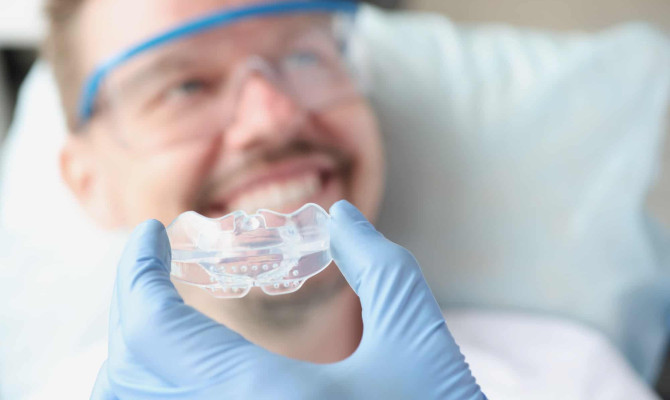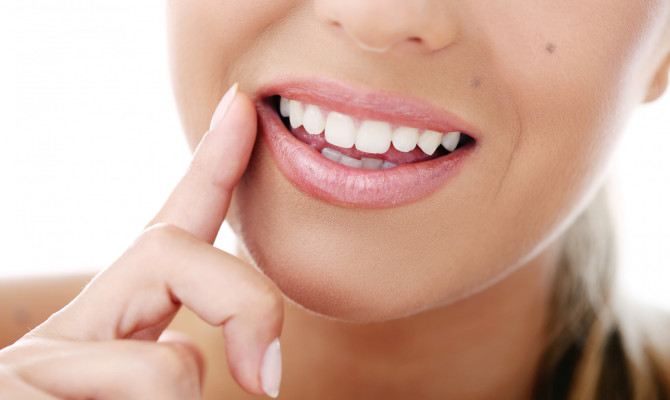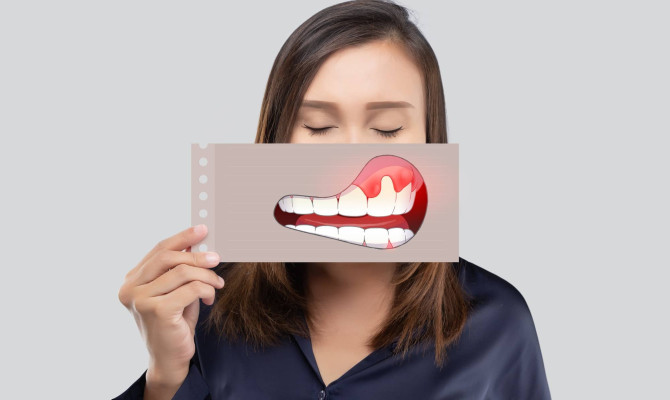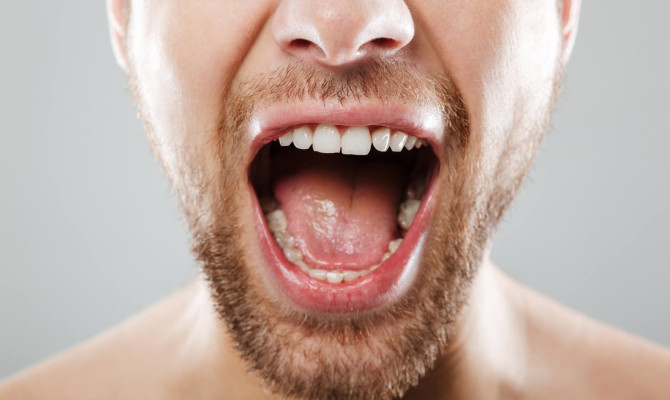What Causes Exposed Tooth Roots? Symptoms & Management

- Gums
- 20 Oct 2023
Introduction
Exposed Tooth Root
An exposed tooth root is a dental condition that occurs when the roots of a tooth become visible and uncovered, often due to the recession of the gum line. This exposure can lead to various dental issues, including heightened sensitivity, increased risk of decay, and potential discomfort.

It is essential for preserving oral health to be aware of the origins, symptoms, and possible therapies for exposure to fruits. We shall look at the causes of this illness in this article. This may indicate root exposure, methods for diagnosis, standard treatment options, preventive measures, and the potential complications if left untreated. By delving into these aspects, an individual can gain valuable insights into managing and safeguarding their dental well-being.
Causes
What Causes Exposed Tooth Roots?
- Gum recession
- Periodontal disease/ Gum disease
- Genetic factors
- Overall hygiene
- Bruxism (teeth grinding)
- Trauma injury
- Orthodontic treatment
- Use of tobacco
Gum recession
- Gradual loss of gum tissue can expose the roots, often resulting from aggressive tooth brushing, disease, or aging.
Periodontal or gum disease
- Periodontitis, an advanced form of gum disease, can cause the gum tissue to be destroyed and the roots to become seen.
Genetic factors
- Genetic predisposition contributes to thinner gum tissue, making people more susceptible to root exposure.
Poor oral hygiene
- Inadequate brushing and flossing can contribute to the accumulation of plaque and tartar, which causes recession and swelling of the gums.
Bruxism
- Persistent grinding or teeth clenching can wear down enamel and contribute to gum recession, exposing the tooth roots.
Trauma
- Gum tissue can be harmed by accidents or injuries to the mouth, potentially exposing it to tooth roots.
Orthodontic treatment
- In some cases, orthodontic treatment may contribute to changes in gum position, leading to root exposure.
Tobacco use
- Gum health can be harmed by smoking or using tobacco products, which raises the danger of gum recession and root exposure. 1 Causes | Researched based study from National Institutes of Health 2 Causes | Researched based study from National Institutes of Health 3 Causes | Researched based study from National Institutes of Health
Symptoms
Exposed Tooth Root Symptoms
- Sensitivity
- Gum recession
- Tooth discoloration
- Pain
- Visible roots
- Swollen or bleeding gums
- Bad breath
- Loose teeth
Sensitivity
- Increased heat or cold sensitivity, especially when ingesting food or drinks.
Gum recession
- Noticeable shrinking or pulling back of the gums, revealing more of the tooth surface.
Tooth discoloration
- Changes in the exposed teeth’ color often appear darker or yellowish compared to surrounding teeth. 2 Symptoms | Researched based study from National Institutes of Health
Diagnosis
Exposed Tooth Root Diagnosis
Dental examination
- A thorough visual examination of the teeth and gums to assess the science of gum recession, discoloration, or other indications of root exposure.
X-rays and imaging
- Dental X-rays may be used to evaluate the extent of root exposure, identify potential dental issues, and assess the tooth’s overall health and surrounding structures.
Periodontal probing
- Dentists may use a periodontal probe to measure the depth of the gum pockets around each tooth, helping to identify any recession and the degree of root exposure.
Patient history
- Discussing the patient’s gentle and medical history, including any recent trauma, orthodontic treatments, or habits like teeth grinding.
Symptom analysis
- Careful consideration of the patient’s reported symptoms, such as sensitivity, pain, or changes in gum appearance.
Discussion of lifestyle factors
- Exploring oral hygiene practices, tobacco use, and other Lifestyle factors that could contribute to gum recession and root exposure. 2 Diagnosis | Researched based study from National Institutes of Health ,3 Diagnosis | Researched based study from National Institutes of Health
Treatment
Exposed Tooth Root Treatment
Desensitizing toothpaste
- Specialized toothpaste can help alleviate the sensitivity associated with exposed roots.
- Ingredients in it lessen the feeling of pain or discomfort brought on by sensitive teeth.
- It has critical components such as Potassium Nitrate nerve signals in the teeth, decreasing sensitivity, fluoride, and strontium chloride.
- Blocking nerve signals, occluding dentinal tubules (tiny channels connecting the tooth’s outer surface to the nerve). 4 Treatment | Researched based study from National Institutes of Health , 5 Treatment | Researched based study from National Institutes of Health
Gum graft surgery
It is a dental procedure designed to trade gum recession by covering exposed tooth roots with grafted tissue. The goal is to restore gum tissue, protect the sources, and improve oral health.
Procedure
- The dentist will typically administer local anesthesia to number the area where the graft will be placed.
- Graft tissues are obtained from different sources, including the patients on the palate (roof of the mouth), donor tissue, or synthetic materials.
- The harvested tissue is carefully attached to the affected areas and secured with stitches or specialized materials.
- The grafted tissue eventually blends in with the gum tissue already there, covering the roots.
- Following post-operative care instructions is advised, including abstaining from particular meals, practicing excellent mouth hygiene, and taking prescribed medications.
Patients should follow their dentist’s recommendations for the best possible recovery as healing timeframes can vary. It is a standard and effective procedure with a high success rate in preserving oral health. 6 Treatment | Researched based study from National Institutes of Health
- If root exposure is accompanied by infection or inflammation, a root canal procedure may be recommended to remove damaged or infected Pulp and Seal the tooth.
- Crowns can be placed over affected teeth to protect exposed roots and restore their appearance and function.
Orthodontic treatment
- Orthodontic interventions may sometimes address misalignment issues contributing to root exposure.
Lifestyle changes
- Advising and implementing changes in oral hygiene practices, including proper brushing and closing techniques to prevent further gum recession.
Addressing underlying issues
- Treating contributing factors such as bruxism (grinding of the teeth), gum disease, or other oral health issues to prevent recurrence.
Regular follow-up care
- Scheduled follow-up appointments to monitor progress, address concerns, and ensure ongoing oral health. 4 Treatment | Researched based study from National Institutes of Health , 5 Treatment | Researched based study from National Institutes of Health
Prevention
Exposed Tooth Root Prevention
Proper oral hygiene
- Use fluoride toothpaste and a soft-bristled toothbrush to gently brush your teeth twice daily. Proper technique helps prevent gum recession.
Regular flossing
- Floss daily to remove plugs and debris between teeth promotes gum health and prevents root exposure progression.
Avoid aggressive brushing
- Brushing too hard can contribute to gum recession. Use gentle, circular motions and choose a soft-bristled brush.
Regular dental checkups
- Schedule routine dental examinations to detect early signs of gum recession or other dental issues.
Use desensitizing toothpaste
- To increase tooth sensitivity, include desensitizing toothpaste in your dental hygiene regimen.
Address bruxism
- Consider wearing a sleep guard if you grind your teeth to prevent additional erosion of the enamel and receding gums.
Quit tobacco use
- Gum disease can be accelerated by smoking and other tobacco usage. Quitting can improve overall gum health.
Balanced diet
- Consumer diet rich in vitamins and minerals promoting overall oral health. Avoid excessive sugar intake.
Protective measures
- Use a mouth protection when engaging in contact sports, which may increase your risk of dental injury.
Manage stress
- Stress can cause tooth grinding. Use relaxation methods to reduce your stress, such as yoga or meditation. 7 Prevention | Researched based study from The National Health Service
By adopting a comprehensive approach to oral care and implementing these preventive measures, individuals can reduce the risk of tooth root exposure.
Complications
Complications of Untreated Exposed Tooth Roots
What are the Dangers of Receding Gums?
Increase sensitivity
- Untreated root exposure can result in increased sensitivity, making it difficult to consume hot or cold foods and beverages.
Dental decay
- Because they lack the enamel covering that protects them, exposed roots are more susceptible to deterioration.
Gum infection
- Bacteria can enter the exposed roots, leading to gum infections (gingivitis or periodontitis) that may cause pain, swelling, and potential tooth loss.
Progressive gum recession
- Without intervention, gum recession may continue exposing more tooth roots and exacerbating the problem.
Aesthetic concerns
- Visible tooth roots can affect the smile’s appearance, causing aesthetic concerns and potentially impacting self-confidence.
Tooth mobility
- Long-term exposure can contribute to the loosening of teeth, leading to mobility and an increased risk of tooth loss.
Chronic discomfort
- The persistent discomfort associated with exposed roots can affect daily activities such as eating and speaking, diminishing the overall quality of life.
Systemic health impact
- Chronic oral health issues, if left untreated, can have severe implications, potentially affecting cardiovascular and overall health. 7 Complications | Researched based study from The National Health Service
FAQs
Frequently Asked Questions About Exposed Tooth Roots
Q. Can an exposed tooth root heal on its own?
- It typically cannot heal on its own. Unlike some tissues in the body, dental enamel, once lost due to gum recession or other factors, does not regenerate.
- However, with the right dental care, the condition’s progression can be controlled and additional harm can be avoided.
Q. Is gum recession normal?
- It is a relatively common dental condition that can gradually occur over time.
- Certain factors and habits mentioned above can contribute to why it is not considered normal because healthy gums ideally remain well attached to the teeth.
Q. What is the most common site of gingival recession?
- The most common site is often observed in the lower front teeth, particularly the mandibular incisors (bottom front teeth).
- This area is susceptible to recession, such as thin gum tissue, improper brushing technique, functional forces, or braces.
Q. Can a tooth with exposed root be saved?
- Yes, it can often be saved with appropriate dental intervention.
Any feedback on this article?
 This Articles content was accurate
This Articles content was accurate Very Informative Article
Very Informative Article I have a question or a comment
I have a question or a comment
 This article contains inaccurate content
This article contains inaccurate content This article was not helpful
This article was not helpful I have a question or a comment
I have a question or a comment
We appreciate your helpful feedback!
Checkout our social pages
References
-
National Institutes of Health
Causes
-
National Institutes of Health
Causes | Symptoms | Diagnosis
-
National Institutes of Health
Causes | Diagnosis
-
National Institutes of Health
Treatment
-
National Institutes of Health
Treatment
-
National Institutes of Health
Treatment
-
The National Health Service
Prevention | Complications





































